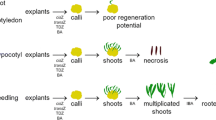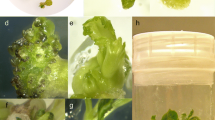Abstract
Hairy nightshade (Solanum sarrachoides) has the potential to be a model system for the study of plant-pathogen interactions, however, the availability of tissue culture and transformation methods would strengthen its utility. For the development of tissue culture methods, we investigated, explant type (cotyledons, hypocotyls, roots), hypocotyl explant origin, cotyledon orientation (abaxial vs. adaxial) in direct contact with the medium, gelling agents (agar and agargel) and cytokinins (zeatin and 6-benzyladenine) at different concentrations. Cotyledon explants resulted in the greatest biomass as compared to root and hypocotyl. As for hypocotyl explant origin, explants proximal to the cotyledons had a significant effect on plant regeneration. However, cotyledon orientation and gelling agent had no effect on plant regeneration. Medium supplemented with either zeatin or 6-benzyladenine at 1 mg L−1 resulted in significant shoot regeneration. Shoots rooted readily when cultured on a non-hormone based rooting medium.





Similar content being viewed by others
References
Abdoli M, Moieni A, Dehghani H (2007) Effects of cultivar and agar concentration on in vitro shoot organogenesis and hyperhydricity in sunflower (Helianthus annuus L.). Pak J Bot 39:31–35
Alvarez JM, Srinivasan R (2005) Evaluation of hairy nightshade as an inoculum source for aphid-mediated transmission of Potato leafroll virus. J Econ Entomol 98:1101–1108
Beruto M, Curir P, Debergh P (1999) Influence of agar on in vitro cultures: II. Biological performance of ranunculus on media solidified with three different agar brands. In Vitro Cell Dev Biol Plant 35:94–101
Bhatia P, Ashwath N, Senaratna T, Midmore D (2004) Tissue Culture Studies of Tomato (Lycopersicon esculentum). Plant Cell Tissue Organ Cult 78:1–21
Bhatia P, Ashwath N, Midmore D (2005) Effects of genotype, explant orientation, and wounding on shoot regeneration in tomato. In Vitro Cell Dev Biol Plant 41:457–464
Blackshaw RE (1991) Hairy nightshade (Solanum sarrachoides) interference in dry beans (Phaseolus vulgaris). Weed Sci 39:48–53
Boydston AR, Mojtahedi H, Jim CM, Brown RC, Anderson T (2008) Effect of hairy nightshade (Solanum Sarrachoides) presence on potato nematodes, diseases, and insect pests. Weed Sci 56:151–154
Cassells AC, Collins IM (2000) Characterization and comparison of agars and other gelling agents for plant tissue culture use. Acta Hort 530:203–212
Chaudhury A, Qu R (2000) Somatic embryogenesis and plant regeneration of turf-type bermudagrass: Effect of 6-benzyladenine in callus induction medium. Plant Cell Tissue Organ Cult 60:113–120
Chen J-T, Chang W-C (2002) Effects of tissue culture conditions and explant characteristics on direct somatic embryogenesis in Oncidium `Gower Ramsey’. Plant Cell Tissue Organ Cult 69:41–44
Costa MGC, Alves VS, Lani ERG, Mosquim PR, Carvalho CR, Otoni WC (2004) Morphogenic gradients of adventitious bud and shoot regeneration in epicotyl explants of Citrus. Sci Hortic 100:63–74
Dandurand L, Knudsen G, Eberlein C (2006) Susceptibility of five nightshade (Solanum) species to Phytophthora infestans. Am J Potato Res 83:205–210
Das MK, Rajaram S, Mundt CC, Kronstad WE (1992) Inheritance of slow-rusting resistance to leaf rust in wheat. Crop Sci 32:1452–1456
Deahl KL, Jones R, Wanner LA, Plant A (2005) Late blight caused by Phytophthora infestans on Solanum sarrachoides in Northeastern Maine. Plant Dis 89:435
Deahl KL, Jones RW, Perez FM, Shaw DS, Cooke LR (2006) Characterization of isolates of Phytophthora infestans from four Solanaceous hosts growing in association with late blight-infected commercial potato crops. Hort Sci 41:1635–1639
Demircan T, Akkaya M (2010) Virus induced gene silencing in Brachypodium distachyon, a model organism for cereals. Plant Cell Tissue Organ Cult 100:91–96
Düzyaman E, Tanrsever A, Gunver G (1994) Comparative studies on regeneration of different tissues of tomato in vitro. In: Second symposium on protected cultivation of Solanacea in mild winter climates, Adana, Turkey, 13–16 April 1993, pp 235–242
Edmonds JM, Chweya JA (1997) Black nightshades: Solanum nigrum L. and related species promoting the conservation and use of underutilized and neglected crops. In. International Plant Genetic Resources Institute (IPGRI). Rome, Italy, p 9
Fahn A (1990) Plant anatomy, 4th edn. Pergamon Press, Elmsford, NY
Goh CJ, Sim GE, Morales CL, Loh CS (1995) Plantlet regeneration through different morphogenic pathways in pommelo tissue culture. Plant Cell Tissue Organ Cult 43:301–303
Goodin MM, Zaitlin D, Naidu RA, Lommel SA (2008) Nicotiana benthamiana: its history and future as a model for plant-pathogen interactions. Mol Plant Microbe Interact 21:1015–1026
Gubis J, Lajchová Z, Faragó J, Jurekova Z (2004) Effect of growth regulators on shoot induction and plant regeneration in tomato (Lycopersicon esculentum Mill.). Biologia. Bratislava 59:405–408
Ivanova M, Van Staden J (2011) Influence of gelling agent and cytokinins on the control of hyperhydricity in Aloe polyphylla. Plant Cell Tissue Organ Cult 104:13–21
Laine EP, Leger RM, Arndt PA, Calhoun L, Garratty G, Petz LD (2000) In vitro studies of the impact of transfusion on the detection of alloantibodies after autoadsorption. Transfusion 40:1384–1387
Lee L, Palukaitis P, Gray SM (2002) Host-dependent requirement for the Potato leafroll virus 17-kDa protein in virus movement. Mol Plant Microbe Interact 15:1086–1094
Liberman R, Shahar L, Nissim-Levi A, Evenor D, Reuveni M, Oren-Shamir M (2010) Shoot regeneration from leaf explants of Brunfelsia calycina. Plant Cell Tissue Organ Cult 100:345–348
Ma G, Lü J, da Silva J, Zhang X, Zhao J (2011) Shoot organogenesis and somatic embryogenesis from leaf and shoot explants of Ochna integerrima (Lour). Plant Cell Tissue Organ Cult 104:157–162
Magyar-Tábori K, Dobránszki J, Teixeira da Silva J, Bulley S, Hudák I (2010) The role of cytokinins in shoot organogenesis in apple. Plant Cell Tissue Organ Cult 101:251–267
Marutani-Hert M, Evens T, McCollum G, Niedz R (2011) Bud emergence and shoot growth from mature citrus nodal stem segments. Plant Cell Tissue Organ Cult 106:81–91
Meinke DW, Cherry JM, Dean C, Rounsley SD, Koornneef M (1998) Arabidopsis thaliana: a model plant for genome analysis. Science 282(662):679–682
Nitzan N, Boydston R, Batchelor D, Crosslin J, Hamlin L, Brown C (2009) Hairy Nightshade is an alternative host of spongospora subterranea, the potato powdery Scab pathogen. Am J Potato Res 86:297–303
Pérez-Tornero O, Tallón C, Porras I (2010) An efficient protocol for micropropagation of lemon (Citrus limon) from mature nodal segments. Plant Cell Tissue Organ Cult 100:263–271
Piovan A, Caniato R, Cappelletti E, Filippini R (2010) Organogenesis from shoot segments and via callus of endangered Kosteletzkya pentacarpos (L.) Ledeb. Plant Cell Tissue Organ Cult 100:309–315
Puchooa D, Purseramen PN, Rujbally BR (1999) Effect of medium support and gelling agent in the tissue culture of tobacco (Nicotiana tabacum). Science and Technology 3:129–142
Sansberro PA, Rey HY, Mroginski LA, Krivenki MA (2001) Plant regeneration from Ilex spp. (Aquifoliaceae) in vitro. Biocell 25:139–146
Scholten HJ, Pierik RLM (1998) Agar as a gelling agent: chemical and physical analysis. Plant Cell Rep 17:230–235
Sharma P, Rajam MV (1995) Genotype, explant and position effects on organogenesis and somatic embryogenesis in eggplant (Solanum melongena L.). J Exp Bot 46:135–141
Srinivasan R, Alvarez JM (2008) Hairy nightshade as a potential Potato leafroll virus (Luteoviridae: Polerovirus) inoculum source in pacific northwest potato ecosystems. Phytopathol 98:985–991
Srinivasan R, Alvarez JM, Bosque-Perez NA, Eigenbrode SD, Novy RG (2008) Effect of an alternate weed host, hairy nightshade, Solanum sarrachoides, on the biology of the two most important Potato leafroll virus (Luteoviridae: Polerovirus) vectors, Myzus persicae and Macrosiphum euphorbiae (Aphididae: Homoptera). Environ Entomol 37:592–600
Thomas JE (1993) Alternative hosts and the epidemiology of Potato leafroll virus in Queensland. Aust J Agric Res 44:1905–1916
Thomas PE (2002) First report of Solanum sarrachoides (hairy nightshade) as an important host of Potato leafroll virus. Plant Dis 86:559
USDA (2009) PLANTS Profile, Solanum L. nightshade. Accessed 14 July 2011
Wikipedia (2009) http://en.wikipedia.org/wiki/Leaf. Accessed 14 July 2011
Zimmerman TW, Robacker CD (1988) Media and gelling agent effect on cotton callus initiation from excised seed hypocotyls. Plant Cell Tissue Organ Cult 15:269–274
Acknowledgments
This paper was supported in part by research funds of Chonbuk National University in 2010 and Basic Science Research Program through the National Research Foundation of Korea (NRF) funded by the Ministry of Education, Science and Technology (2011-0013556).
Author information
Authors and Affiliations
Corresponding author
Electronic supplementary material
Below is the link to the electronic supplementary material.
11240_2011_20_MOESM1_ESM.ppt
Supplementary Fig. 1 Effect of gelling agent on percent of explants with shoots (A) and the number of shoots per explant (C). Effect of explant origin on percent of explants with shoots (B) and the number of shoots per explant (D). Means from 4 replicates (A and B) and from 3 replicates (C and D). Bars represent standard error (±). (PPT 174 kb)
Rights and permissions
About this article
Cite this article
Ju, HJ., Van Eck, J. & Gray, S.M. Factors influencing plant regeneration from seedling explants of Hairy nightshade (Solanum sarrachoides). Plant Cell Tiss Organ Cult 108, 121–128 (2012). https://doi.org/10.1007/s11240-011-0020-x
Received:
Accepted:
Published:
Issue Date:
DOI: https://doi.org/10.1007/s11240-011-0020-x




